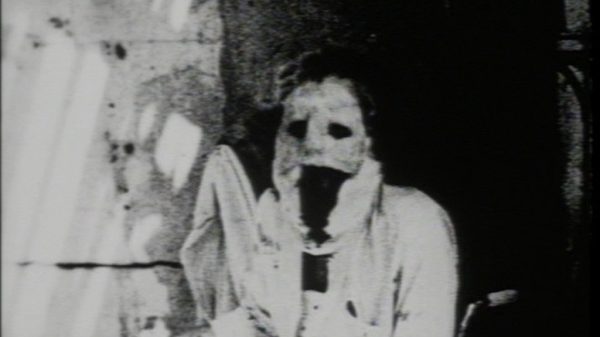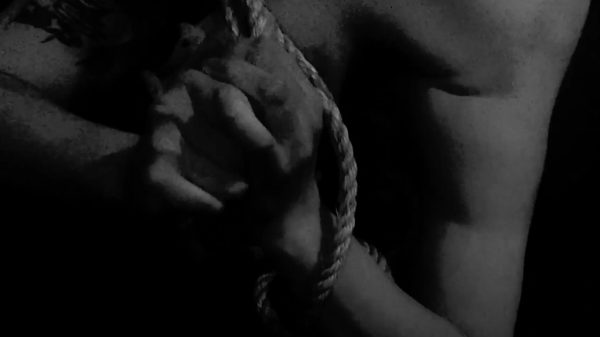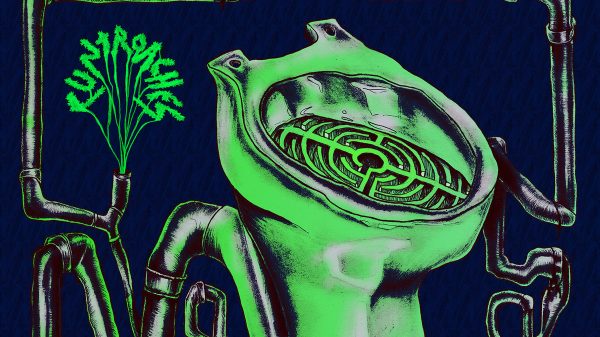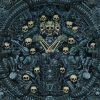There is a very interesting story behind the origin of the Killekill record label. Originally the Killekill project, based in Berlin, used to host a weekly club night at Berghain Kantine, featuring experimental electronic producers and visual artists, among more. The hype for those nights must have been quite high, and soon enough Killekill expanded its reaches and moved into the physical format domain, releasing many records from the artists participating at their club nights. Today, the label marks with Megahits II its 25th release, described as the moment that closes one chapter, just to introduce the next. The manner in which the tracks of these twelve artists are arranged in this compilation suggests that the label will split into three sub-divisions, each with its own distinct sound, in an attempt to feature even more artists, and focus on more releases in the future.
Megahits II Review
The first record of the compilation is also the more experimental in terms of approach and sound. Opening with the mysterious, alien-like approach of Umwelt, “Gravitational Lens” transfers the listener to a subliminal garden of electronic bliss, as the producer steadily introduces more elements to his post-club structure. The fleeting sounds of Eomac’s “Angel In The Marble” cause sonic dissonance in the succession of different parts, with the experimental, noise outlook contained in the repetitive patterns of his work. Moving into tribal territory, Dez Williams’ “Drakonia” mixes up the electronic setting with the transformative percussion elements, as simple lines add more movement to the already evolving scenery. Bintus’ closes the first record with his erratic, noise-prone “Re-Clocking Knob,” playfully switching the tempo and introducing a fair amount of an acid influence.
The second record takes over with a more dystopian vision towards a post-dance stage. Legendary Detroit Grand Pubahs are presenting their electro outfit Techmarine Bottom Feeder (you can’t make that shit up!) with the steady beat and voice samples constructing their post settings in “Demon Particle Influence.” The Fool’s Stone, project of electro mythic figure Adriano Canzian, Italian artist Brigida and Hard Ton, sees the trio moving into heavy drum&bass with “Nonversation,” while crafting a very vibrant and, at the same time, dark interpretation of electro music. In more upbeat fashion, underground legend Jerome hill, brings more energy and urgency with “Memory Machine.” His excellent use of tempo and rhythmic patterns results in an infectious groove, which however is not devoid of a more sinister touch, as the track progresses. In an explosive fashion, Furfriend bring bombastic elements forth in “Numb,” leaning towards an industrial foundation with the repetitive patterns and the dissonant injections along the heavy beats, introducing as well a minimal setting that is easily one of the best moments of the track.
For the third record, Kamikaze Space Programme make an excellent introduction with their bell-driven percussion in “Absence.” Basing their track around a drunken methodology they give a very unique sound and organic progression. In a more upbeat and energetic fashion, Cassegrain & Tin Man join in, without however not letting a dark perspective creep in their track, “Ad Hoc.” The way the beats are set-up is excellent, and the introduction of additional elements is intriguing. One step further is Blake Baxter’s route in “Acid Warp Time Travel” adding a few tribal elements on top of his experimental synths, giving a quite futuristic entry to this work, as the track becomes busier and more erratic. The final step sees Alex Cortex unveiling a horrific, vibrant synth theme on top of a steady rhythm section. The addition of elements is done very nicely, however it is the bass lines that completely steal the show, with the sonic manipulation that Cortex applies through its duration resulting in moments of complete bliss.
The three records that this compilation is split down to can be considered a prelude to the character that each of the three sub-divisions of the label will take on. Experimental moments, more straightforward dance tracks, acid influences are just some of the areas explored in this collection, and Killekill prove that they very well know the landscape of the electronic scene, and how to cherry pick their artists. Their vision with the division of the main label promises that we will see much more of that quality in the future, but it will also increase the quantity. I got absolutely no issue with that!
Umwelt Interview
Umwelt is a legendary figure in the electronic music scene. It is not a coincidence that the Killekill compilation opens with his track “Gravitational Lens.” Active for over twenty years, having experienced the rave and electro movements of the French scene first hand, he has initiated labels and produced tens of releases through his career. In this in-depth interview he discusses his unique workflow, pressing his own records, his experience in the electronic scene through the year, his contribution to Megahits II, as well as the Cronenberg influence and the difference in the natures of digital and analog formats.
Hello! Firstly, thanks for finding the time to do this interview, it is much appreciated! So, would you like to give an overview of you career under the Umwelt moniker?
I began as a DJ for rave parties and on the radio at the beginning of the 90s. I began to produce at the end of the 90s, and I launched my first label, Fundata Records in ’98. I’ve made around thirty EPs and two albums on different labels.
What is the origin of the name Umwelt? It is German, if I am not mistaken, and translates to “environment.” What is the connection you are trying to highlight between your music and the environment? Does it refer to nature or a person’s surroundings in the more generic sense?
When I chose this name, I had never been to Germany. My girlfriend had made a t-shirt “Umwelt freundlich,” which I found nice, and this simple word, “Umwelt,” which deals with Earth and Nature, opens up other aspects of the nature…the human one. It also deals with the sensory environment; we all live in the same environment, but we get things differently. It is the same thing with music or dance.
Party after party, I noticed that the public has very different natures from one party and one place or one city to another. All these parameters make the place homogeneous and diverse at the same time. Human environments can be very “animal,” with an “organic” public, or “hard,” which seems to come from the bowels of Earth, from the wood, the bitumen… or more “cerebral,” which constitutes an aerial and lightweight crowd.
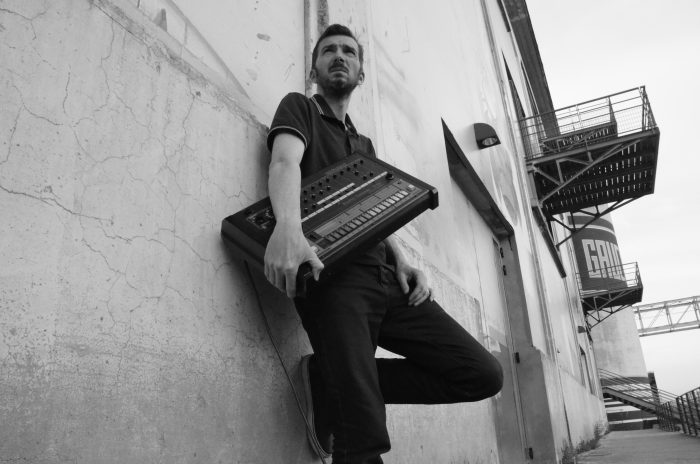
I have heard very interesting things about the manner in which you produce your tracks. Can you discuss your methodology in terms of composition? Is it true that you produce all your tracks in one take? Do you apply any additional elements or processing afterwards?
Yes, that’s true, I build my tracks a little bit like a DJ – instinctively. I spend a lot of time programming sounds. Sometimes, I make sessions during which I connect my machines together. I record several versions and, when I switch off my machines, everything disappears, except few 303 and 808 sequences.
In the past, you described your studio as having an old-school setup. Can you go into a bit more detail on the specific parts that make up your production chain? Which synths do you mostly use? Are there any audio effects that you use separately on your signal chain? In the aforementioned interview, you stated you were using a MPC as the centre of your setup. Is that still the case, and would you not consider that some alternative might be easier to use?
Yes, I used MPC for a long time, then I changed, two years ago, to Octatrack to get my setup more intuitive. Octatrack is a great machine to build live pieces. I do not use computer except for the recording of my tracks. I tried Cubase on a Mac, but I found it boring. Currently, I have a setup which works pretty well. From time to time, I change my machines to bring some new sounds and flesh. I don’t like to use the same old recipes or the same types of sounds, I prefer to take the risk of exploring other tones and musical universes. I use many effects that I plug with various machines. Nothing is deadpan. My masterpiece is the TR808. It is present in all my tracks and plugged with several analog synth and effects.
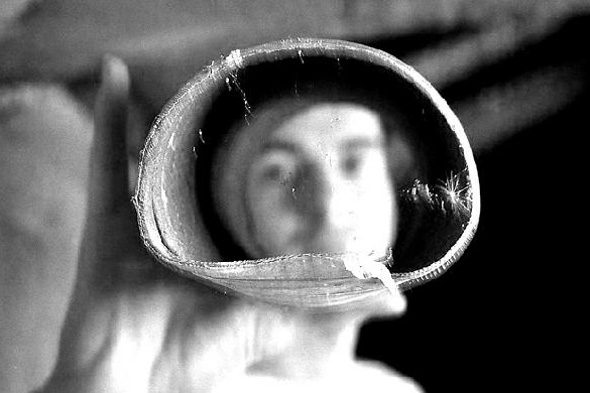
Another intriguing thing I heard is that you press on your own the records that you will play on your sets. May I ask what lacquer cutter you are using? And what is it that made you take that decision, since it takes great commitment to do so?
Indeed, I’m cutting a part of tracks I play at parties. They are unreleased tracks which have not yet found a vinyl issue. It is not lacquer, but hand-cut on blank vinyl. It is the same process as the cutting on lacquer. The cutting requires a good technique and a long practice. At the beginning, I threw New Flesh by publishing exclusively limited cutting series. I still make it from time to time, essentially for the ambient and drone 7″ releases on New Flesh Lab. In parallel, I have a small company for vinyl cutting, My Vinyl.
Even though your sound is very diverse, I cannot help but feel a strong rave foundation. Is that the point of origin for yourself as a producer? Also, do you feel that it is the main focus of your work, and no matter how bold and adventurous your approach might be, you need to land back into the rave area?
I began to mix at the age of 15 in the New Beat era and I have been lucky enough to start mixing at the very beginnings of Rave Parties in France. It was a pretty crazy period when I think about it, we didn’t calculate anything and did not know the luck we had to live these fantastic moments.
You are a true veteran of the electronic music scene, and you started out (unless I am mistaken) in the early ’90s producing music. Can you talk about the evolution of your sound across the years? What have been the most important changes you made through your career?
I began to produce by the end of the 90s tracks ranging from techno to electro music. From the years 2000, I didn’t have interest in techno music anymore, the avant-gardist spirit of Rave had disappeared. I stopped mixing in order to concentrate myself on musical production. I continued to buy records and to listen to a lot of music. I discovered a whole electro scene with labels such like Electrix, Breakin’, Monotone Satamile and Kommando 6 which brought something new. I then have been more interested by atmosphere and emotion. Since few years, I orientated myself further on the emotional aspect a track can bring on a dancefloor.
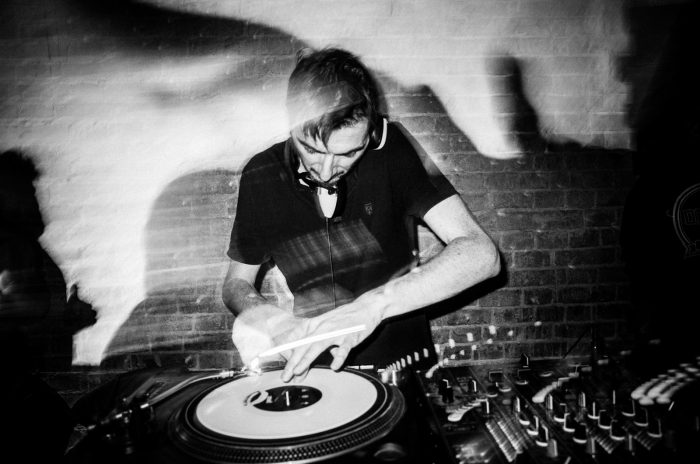
In the past you had a radio show, Teknoland. What did you find most interesting in hosting a radio show? Did you enjoy promoting music that you found to be interesting and run live sessions of other producers? Is that something that you ever continued after Teknoland?
I reckon you are well informed! Yes, I began a radio show called “Teknoland’ in 1993 on Lyon, with Dj Nessie, my alter ego. It is rather funny how everything went very fast. After I met the right people at the right moment, I found myself launching a radio program and playing at parties in the very beginning of the Rave movement in Lyon. We were announcing infolines for parties on air. On the radio, we were welcoming guests DJs such as Mike Dred, Dj Deg or Robert Leiner when they were playing at parties in Lyon. Things had grown so much that the Radio received orders to stop the show because of police pressures. By searching well, you can still find videos of this period on YouTube. After Teknoland, I joined another radio show, “Techline,” on a student radio called Radio Brume. Then I started the Teknocity show on Radio Pluriel. After a break of ten years, I recently started a monthly residency on LYL radio. I’m glad to work on musical programming again. It’s a real pleasure for me to be able to introduce my favorite tracks in a different way than I do at parties.
You have talked in the past about the forgetfulness of digital releases. I personally agree that vinyl far and beyond any other format of music, but there is a certain ease in digital files that people find appealing. What is your position on that? Do you feel that the quality is just lesser (even if we are talking about uncompressed .wav files and not crappy .mp3 files) and therefore it will always be a step behind?
Digital is a pure product for the mass consumer society which I’m not very interested in… except for its practical side, because we can stock lot of tracks in a smartphone or any USB reader… even if we still need to find tons of things which make us vibrate.
About the contest between a vinyl DJ and a digital DJ – there is no comparison for me. Vinyl is alive, its frequencies are very different. Digital is completely compressed and formatted. The thing which interests people isn’t the sound quality, but the volume. What makes me laugh is that the fashion of B2B comes from digital technology. Every DJ appears behind his CDJ, often without headphones, mixing tracks like a zombie.
Hardest should be to mix both (vinyl and digital) because you hardly have the same frequencies: the digital is quite compressed, there is often only bass while the vinyl allows to inject lot of medium and treble.
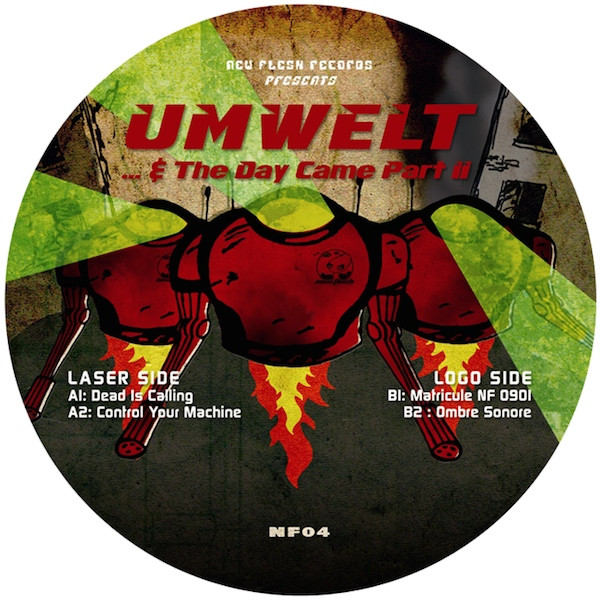
Through the years, you have started a few different record labels, including Shelter, Fundata and New Flesh (and its sub-label Rave Or Die). Can you explain your reasoning in initiating a number of different labels in order to release your own music, and that of others? Do you feel that a DIY approach is more appropriate in today’s music scene? How do you go about choosing music from other artists to release through your labels?
My labels correspond to steps of my creative life. It’s like my music, it’s all about the feeling, I don’t really care about fashions. That’s nice because now there is a focus on my sound and my labels but for 20 years, they were rather reserved for initiated. What I love is to live “around the vinyl,” the music and the meetings. In fact, it is my mission to find original artists even if, from time to time, they find me. I do not know if we can speak about pure DIY because, for example, the majority of vinyl which we bring out are pressed but in any case, we manage all the artistic line.
Also, regarding the name New Flesh for your label, I was wondering if that is a reference to David Cronenberg‘s Videodrome? Is there an influence from films or any other sources that has managed to creep into your music and compositions? If so, I would be interested to hear your opinion on Tsukamoto‘s Tetsuo.
Yes, it is a big influence. I love the complexity of Cronenberg’s movies, the unhealthy aesthetics, the philosophy. They are prophetic works; Cronenberg is a visionary. In the Videodrome movie, we find a strong Cronenberg theme: the fusion between the spirit, the body and the machine. I sampled many Cronenberg’s movies, the most known being “You Murder The Future” off the movie Scanner. I like movies with rather dark and surrealist aesthetics. Tetsuo is a great classic of the fantastic cinema too, and as in Videodrome, the human-machine mutation is dominating.
You have also released music through Helena Hauff‘s Return to Disorder label. Can you tell us how this came to be? Is there a mutual admiration between yourself and Hauff? Both her 2015 albums, Discreet Desires and A Tape were some of my favourite releases of 2015.
Yes, of course, I love Helena’s music and she is a great DJ. It’s true that we have many common influences, even if we are not the same age old. I met Helena in June last year when she came to play in Lyon for the first time, it was in the Terminal Club. We knew each other artistically, but we had never met. We talked about music and politics, it was nice. We saw each other again in August at the Krake Festival in Berlin. She spoke to me about her label and suggested me making an EP. I sent her tracks which she released since.
Your most current contribution for the Killekill compilation, Killekill Megahits II. How did this contribution came to be? Where you approached by the label? What can you tell us about your track, “Gravitational Lens,” that appears in the collection? Also, I have heard that you will be releasing a new album through Killekill in the near future. Can you tell what we should expect?
I met the Killekill crew during the last edition of Krake; Nico and Alienata followed my music for quite a long time and they invited me to be in Krake. We felt fine immediately. Musically, I have many common points with Alienata, she is also a great DJ. After Krake, Nico asked me for tracks for Killekill, and one month later he offered me to do an album. “Gravitational Lens” from the Killekill Megahits II is an introduction to the album which will be in the same Electro vein, dark and mellow.
I am very curious to find out your opinion on the state of electronic music today. Do you feel that in this age, where everything is just a mouse click away, there is room for true originality? And what do you think will be the future of the scene in terms of sound? What is it that is going to grab people’s attention?
The way of listening and consuming has considerably changed in 20 years. Back in the days, if you wanted to find a record, you were going to your record dealer and gave him a description of the track by humming it, and he gave you the record. Today, everybody produces music at home and publishes it on Internet. It is not possible to listen and know everything. When you look for a track, you just have to post the “track id” and hope that someone answers your request. What frustrates me the most is that I always have the feeling of passing on the ultimate track. So, I spend most of my evenings listening to DJ mixes that I follow or to listen to billions of Soundcloud or YouTube’s links to find the track which will make the difference. I became more and more selective over the years. Making vinyl DJ sets forces you to be selective and to refine your selections. I think this is an asset.
Despite all the possibilities that machines and softs offer, no big musical trend appeared since the techno and the hip-hop. I have a feeling that everything is cyclic. At the moment, there is, for example, a big EBM and New Wave revival tinted with industrial techno. Globally, the current scene is rather dark. Who knows what will be at the top in two years? The new generation seems to be more open and more critical at the same time, it is a good thing.
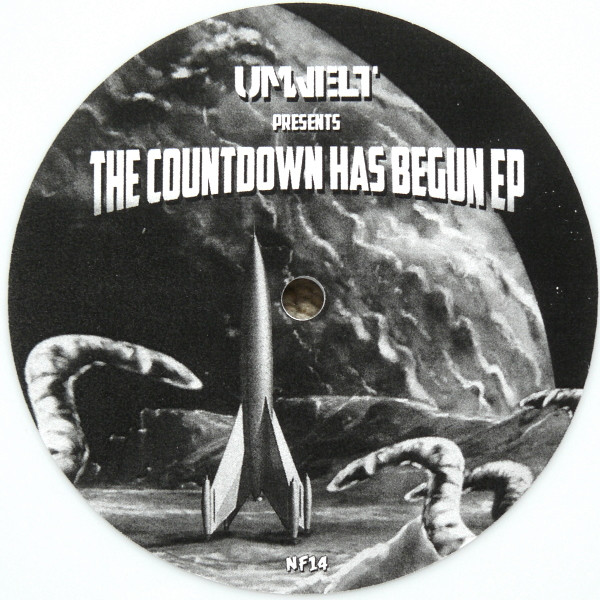
What are your future plans? Both in terms of Umwelt, but should we also look forward to any other artists/project releases through your record labels?
My aim is to keep on developing labels and finding artists who drive things forward. On the personal side, I have an album which is coming out in October on Killekill and two other EPs by the end of the year; one is already finished, it will be out on the excellent Greek label Modal Analysis, and the second, which is still in progress, for a good French label. Splits are planned on Rave Or Die. The next will be with one of my favorite producer: The Exaltics. For New Flesh, I continue to develop artists I love with a less accessible, sharp selection. Next New Flesh Records will be an EP from a young Irish artist, RogueFrequency, and the following one looks even more epic because of its Miami Bass and AFX Style mixed tones.
Do you have any live sessions and gigs that you would like to mention?
Not especially in particular. I meet great people every time. I am lucky enough to have had the opportunity to evolve in an environment where the promoters are often passionate and book me for what I’m doing, and not according to my likes on Facebook. My journeys allow me to meet scenes and local activists.







